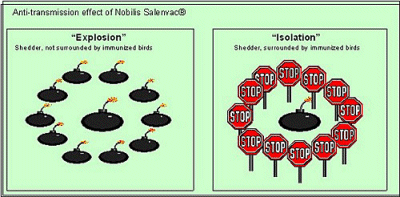Salmonella control – The Hatchery
Salmonella control in the hatchery is based on good hatchery management and vaccination of breeders to provide maternal immunity against salmonella infection in the day old chickens.
An effective hatchery code of practice should include:
- Spatial or temporal segregation of high-risk flocks.
- One-way system for the flow of eggs, chicks, trolleys and trays.
- Good hygiene.
- Air-flow from dirty to clean areas.
- Efficient handling of waste that accumulates during production.
EU Directive 92/117 made monitoring for Salmonella mandatory. Samples for culture can be collected from:
- Fluff.
- Hatcher basket and delivery-box liners.
- Broken eggshells.
- Macerated waste.
- Meconium.
- Dead-in-shell chicks.
Fluff, hatcher basket-liners and delivery-box liners are best for sampling. This ensures that Salmonella serotypes that do not invade the eggshell are also detected.
Positive samples should be traced to supply flocks.
Buildings and surfaces should be designed to facilitate cleaning and disinfection. Swabs should also be taken after the cleaning and disinfection of buildings and equipment to check for the persistence of Salmonella.
Vaccination of Breeders
When the parent birds are vaccinated against Salmonella, the chicks are protected by maternal antibodies in the hatchery. This will limit the spread of Salmonella infection in the hatchery.
Read about Salmonella vaccines.

